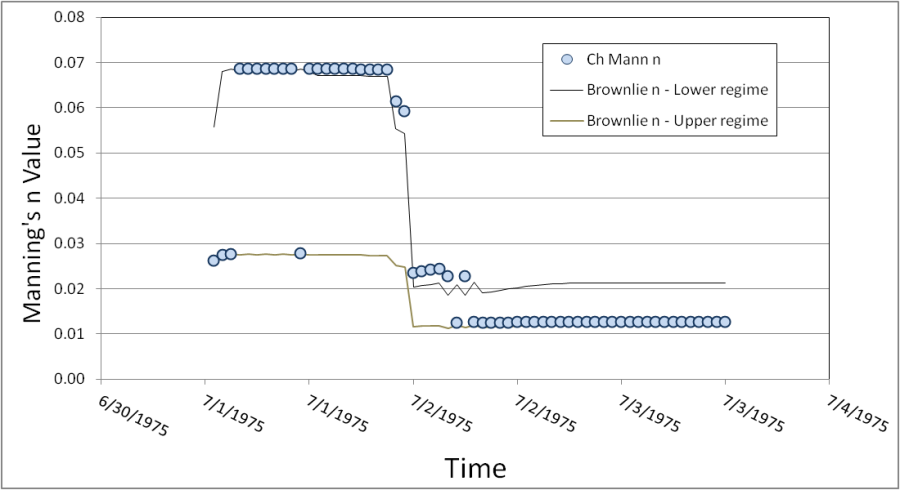The Brownlie (1983) computes bed roughness in sand beds where form roughness (bed roughness from bed forms) is much more important than grain roughness. The Brownlie method computes bed roughness base on the median particle size (d50), the hydraulic radiI(R), the bed slope (S), and the geometric standard deviation of the mixture (σ). Because the Brownlie method is based on bed form mechanics it can shift between upper and lower regime relationships, causing non-linear changes in n-value:
Upper Regime:
|
n = \left[ 1.6940 \left( \frac {R}{d_5_0} \right)^{0.1374} S^{0.1112} \sigma^{0.1605} \right] 0.034(d_5_0)^{0.167} |
Lower Regime:
|
n = \left[ 1.0213 \left( \frac {R}{d_5_0} \right)^{0.0662} S^{0.0395} \sigma^{0.1282} \right] 0.034(d_5_0)^{0.167} |
Where R is the channel hydraulic radius in ft, d50 is the meidian particle size in ft, σ is the geometric standard deviation of sediment mixture: \sigma = 0.5(\frac{d_8_4}{d_5_0} + \frac{d_5_0}{d_1_6})
Brownlie defined S as the bed slope, HEC-RAS approximates this variable with the energy slope computed at the cross section.
To determine which equation to apply, HEC-RAS uses the Brownlie criteria to identify the regime.
If S>0.006, HEC-RAS always assumes the system is in the upper regime. Otherwise, Brownlie computes an empirical parameter Fg'
|
F'_g = \frac{1.74}{S^{1/3}} |
which can be compared to the grain Froude number Fg:
|
F_g = \frac {V} {\sqrt{(S_s - 1) g \space d_5_0}} |
(where V is the flow velocity, g is the gravitational constant andSS is specific gravity of sediment particles).
HEC-RAS selects the lower regime flow if Fg≤Fg' and upper regime if Fg≥Fg'. An example application of Brownlie in HEC-RAS, for a sand pulse arriving at a gravel cross section, is included in the figure below.
